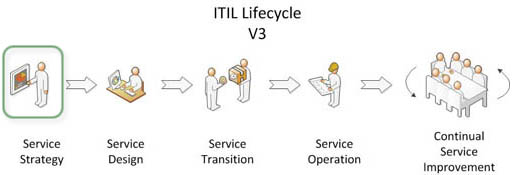The goal of Service Strategy is to better align the business and IT strategy to ensure that IT services provide business value. The strategy of the services deals with how to design, develop and implement services.

The Service Strategy stage provides guidance on how to view Service Management as a strategic asset. Topics covered in Service Strategy include:
- Development of service markets
- Characteristics of internal and external provider types
- Service Assts
- The Service Portfolio
- Financial Management
- Demand Management
- Organisational Development
- Strategic Risks
Using strategy we set objectives and target expectations of service performance for our customers and the market spaces. These opportunities are identified, selected and prioritised. We also ensure that the company is in the position to absorb costs and risks associated with their Service Portfolio. We strive to not only ensure the company is primed for operational effectiveness but also for optimal performance.
Service Strategy covers the following key concepts:
- Creating value
- Service assets
- Defining the service market
- Developing service offerings
- Service capabilities and resources
- Service Provider types
Service strategy is not easy. It involves communications and sponsorship that can come from different business cultures and backgrounds. Service strategy is an advanced function because it's cultural, with emotion and politics weaved in. IT service managers run into this all of the time, so when organisations are not aligned with goals or visions, we evidently see that the company is just reactive rather than proactive. They're doing everything to keep the company afloat and running, but no more. There's no drive to improve the business function, no continual improvement or high level strategy behind the day to day fire fighting.
When you see this kind of fragmentation it's easy to see business processes breaking down, degrading and melting away. We see constant battling to keep things alive and keep the 'engine running'. This manifests in a different number of ways from employees working long hours and staff moral getting down.
Using Service Strategy it's about being able to say maybe if I wasn't so reactive maybe we could have thought about the compliance and governance, that its not about having an audit or being exposed or getting exposed and then having to patch it up later. Success brings about success by starting small.
When we talk about Service Strategy we talk about alignment and efforts, visions and goals. Using Service Strategy we learn to build the core strategy and that's where things start to happen, the light bulbs light up and we drive towards operation health. All of these things are essential to helping an organisation to succeed!
See also:Sourcing governance
Governance domains
Governance body
The Four P's of strategy
Market spaces
Trend Analysis